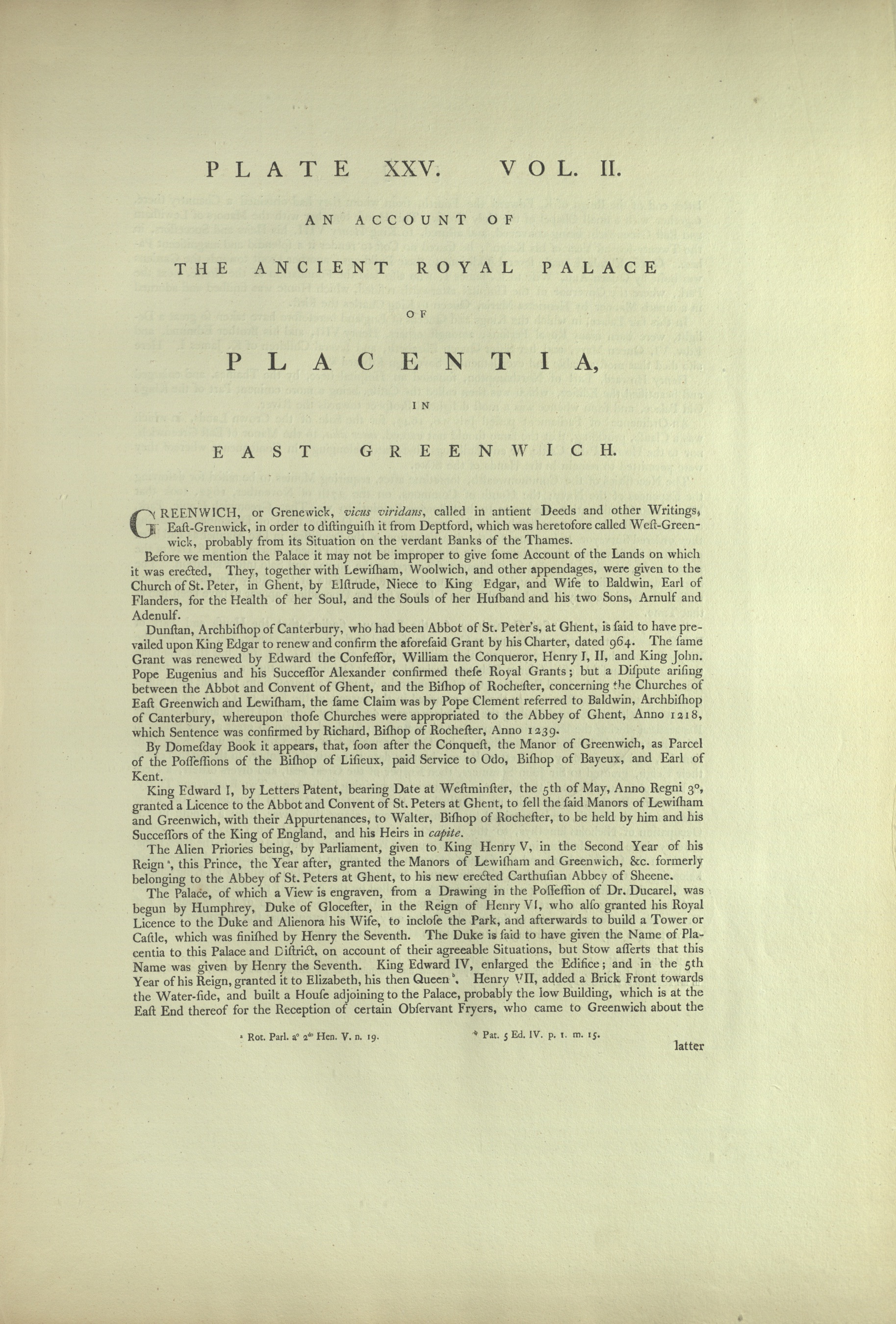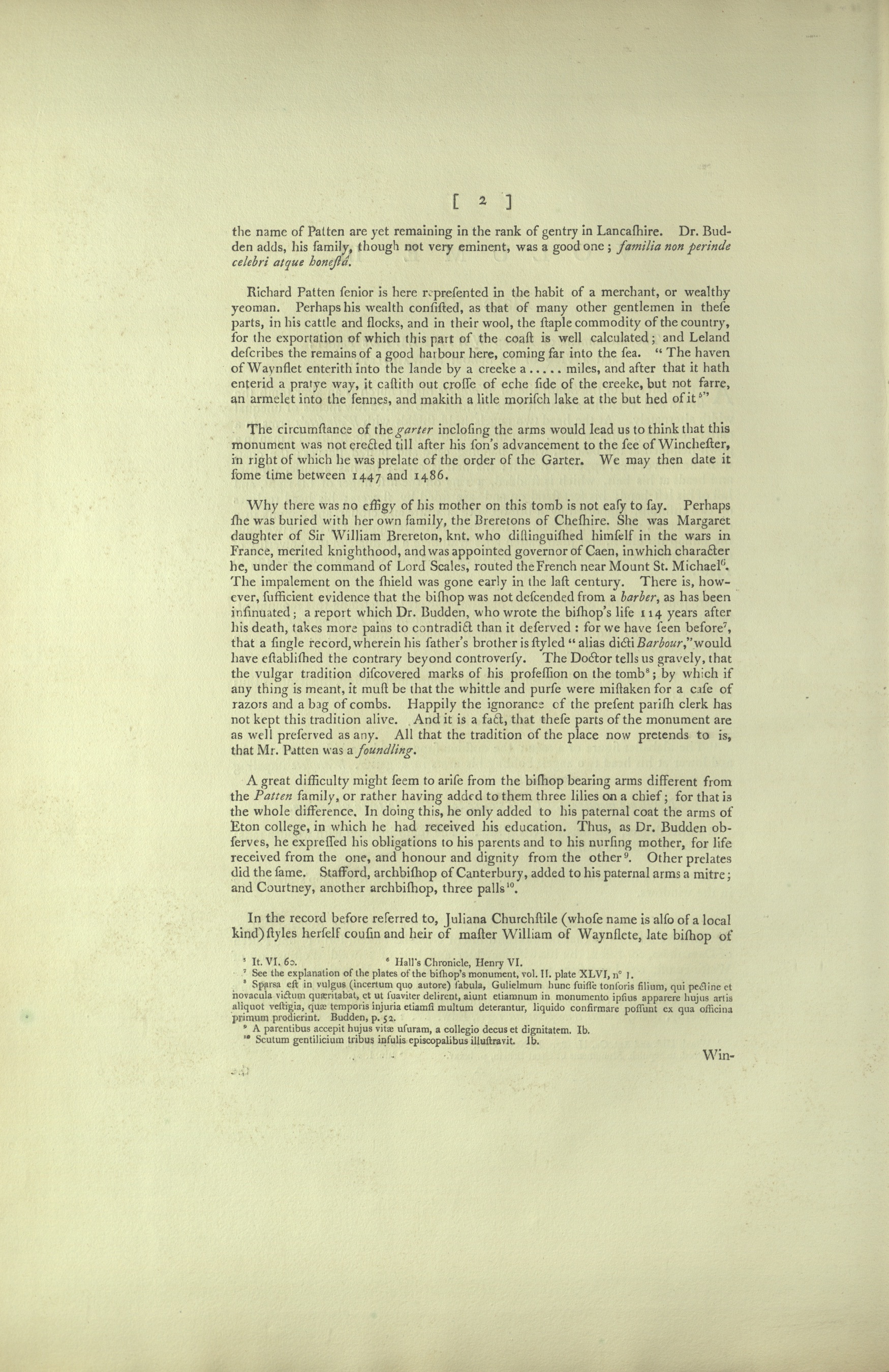
Creative Commons Attribution-Noncommercial-No Derivative Works 3.0
Plate 2.25: Palace of Placentia (Original Explanatory Account)
1 media/vm1-02-cropped.jpg 2020-07-04T22:21:48+00:00 Yoonjae Shin 619e43eddefcc0738b0901bde8aba8bfde4d3041 31 8 Original Explanatory Account for Vetusta Monumenta, Plate 2.25. plain 2020-08-08T18:57:00+00:00 Quanah Leija-Elias fc578bb41a53b12f2a08253bc8cc52547b2ff8bb
[(Page) 1]
PLATE XXV. VOL. II.
AN ACCOUNT OF THE ANCIENT ROYAL PALACE OF PLACENTIA, IN EAST GREENWICH.
GREENWICH, or Grenewick, vicus viridans, called in antient Deeds and other Writings, East-Grenwick, in order to distinguish it from Deptford, which was heretofore called West-Greenwick, probably from its Situation on the verdant Banks of the Thames.
Before we mention the Palace it may not be improper to give some Account of the Lands on which it was erected. They, together with Lewisham, Woolwich, and other appendages, were given to the Church of St. Peter, in Ghent, by Elstrude, Niece to King Edgar, and Wife to Baldwin, Earl of Flanders, for the Health of her Soul, in the Souls of her Husband and his two Sons, Arnulf and Adenulf.
Dunstan, Archbishop of Canterbury, who had been Abbot of St. Peter’s, at Ghent, is said to have prevailed upon King Edgar to renew and confirm the aforesaid Grant by his Charter, dated 964. The same Grant was renewed by Edward the Confessor, William the Conqueror, Henry I, II, and King John. Pope Eugenius and his Successor Alexander confirmed these Royal Grants; but a Dispute arising between the Abbot and Convent of Ghent, and the Bishop of Rochester, concerning the Churches of East Greenwich and Lewisham, the same Claim was by Pope Clement referred to Baldwin, Archbishop of Canterbury, whereupon those Churches were appropriated to the Abbey of Ghent, Anno 1218, which Sentence was confirmed by Richard, Bishop of Rochester, Anno 1239.
By Domesday Book it appears, that, soon after the Conquest, the Manor of Greenwich, as Parcel of the Possessions of the Bishop of Lisieux, paid service to Odo, Bishop of Bayeux, and Earl of Kent.
King Edward I, by Letters Patent, bearing Date at Westminster, the 5th of May, Anno Regni 3°, granted a License to the Abbot and Convent of St. Peters at Ghent, to sell the said Manors of Lewisham and Greenwich, with their Appurtenances, to Walter, Bishop of Rochester, to be held by him and his Successors of the King of England, and his Heirs in capite.
The Alien Priories being, by Parliament, given to King Henry V, in the Second Year of his Reigna, this Prince, the Year after, granted the Manors of Lewisham and Greenwich, &c. formerly belonging to the Abbey of St. Peters at Ghent, to his new erected Carthusian Abbey of Sheene.
The Palace, of which a View is engraven, from a Drawing in the Possession of Dr. Ducarel, was begun by Humphrey, Duke of Glocester, in the Reign of Henry VI, who also granted his Royal License to the Duke and Alienora his Wife, to inclose the Park, and afterwards to build a Tower or Castle, which was finished by Henry the Seventh. The Duke is said to have given the Name of Placentia to this Palace and District, on account of their agreeable Situations, but Stow asserts that this Name was given by Henry the Seventh. King Edward IV, enlarged the Edifice; and in the 5th Year of his Reign, granted it to Elizabeth, his then Queenb. Henry VII, added a Brick Front towards the Water-side, and built a House adjoining to the Palace, probably the low Building, which is at the East End thereof for the Reception of certain Observant Fryers, who came to Greenwich about the
a Rot. Parl. a° 2d° Hen. V. n. 19.
b Pat. 5 Ed. IV. p. 1. m. 15.

[(Page) 2]
latter end of the Reign of K. Edward the Fourth, from whom they had obtained a Chauntry there, together with a small Chapel of the Holy Cross.
This House together with the Manors of Lewisham and East Greenwich, being conveyed, and assured, to King Henry VIII, his Heirs, and Successors, in the Twenty-second Year of his Reignc; he spared no Cost to render it a splendid and magnificent Palace. Queen Elizabeth made several Additions to these Buildings; another Front towards the Gardens was built by Queen Ann, Wife to K. James I, who also laid the Foundation of the House, next [to] the park, where the Governor of the Hospital afterwards resided, which House was finished and adorned in a superb Manner by Henrietta Maria, Queen to King Charles the First.
In this fair Palace, in which the Kings and Queens of England heretofore have taken so great a Delight, were born many Royal Persons; amongst others, Henry VIII, and his brother Edmund, and Edw.VI, Queen Mary, and her Sister Queen Elizabeth, and several Children of K. James I. Here also died that most amiable and ever lamented Sovereign Edward VI.
Henry Howard, Earl of Northampton, founded an Hospital here, by the Thames, and enlarged and beautified the Edifice, which was then called the Castle, being a more eminent Part of the King’s Old Palace, and from whence was a most delightful Prospect towards the River.
An Ordinanced of Parliament passed July 16, 1649, for the Sale of the Crown Lands, in which was a Clause, providing, that the same should not extend, inter alia, to the Manor of East Greenwich, nor to the House, Park, Castle, or any Buildings thereunto belonging: in Consequence whereof they were permitted to remain in the Hands of the State.
The Necessities of the Commonwealth, sometime after, requiring Monies to be raised for defraying the Expenses of the Navy; the House of Commons, on the 27th of November, 1652, took that Matter into Consideration, and came to the following Resolution; viz. That Greenwich House, Park, and Lands, should be immediately sold for ready Moneye. On the sixth of Decemberf following they ordered Surveyors to be sworn for the due Valuation of the Premisses, in like Manner as had been prescribed for surveying other Estates of the late King, Queen, and Prince; and on the 31st Day of the same Month, the House passed an Ordinance for carrying the Survey and Sale into Execution. The Survey was accordingly taken, and Particulars made out for the Sale of the Hoby Stables, and some trifling Parts of the Royal Garden and Palaceg, but no further Proceedings appear to have been had at that Time.
In the year 1654, theh Sub-Committee, for the Revenue, finding that the House and Park of East Greenwich, together, with Hampton-Court House and Park, Somerset House, &c. and other [of] the King’s Palaces, had been surveyed, and the Buildings valued at 25,969 l. 6 s. 6 d. but that the same then remained unsold, after solemn Debates, declared as their Opinion, that they are fit Places for the Accommodation of the Lord Protector, therefore not to be valued at any gross Sum, yet that they might be allowed toward the Revenue as they are returned in the Survey, at the Rent of 1254 l. 33 s. 4 d.
King Charles the Second, finding the old Palace greatly decayed by Time, and the Want of necessary Reparations during the Usurpation, soon after his Return to England, began to erect a New Palace in this Place; but it being left unfinished at his Death, remained in that Condition until King William III, and Queen Mary, by Letters Patent, bearing date the 25th of October, in the Sixth Year of their Reign, granted to Sir John Sommers, then Keeper of the Great Seal, and divers others, a Piece or Parcel of Ground, Part of the Manor of Greenwich, containing Eight Acres, Two Roods, and Thrity-two square Perches, and which, as described in those Letters Patent, is bounded by the River Thames on the North, and contained by Admeasurement, along the River, from a House in the Occupation of Nicholas Smythys, to the East End of the Edifice called the Vestry, Six Hundred Seventy-three Feet, abutting in Part, East, on the public Way, leading from the Crane to the Back Lane, South on the Old Tilt-Yard and the Queen’s Garden, and West on the Fryer’s Road and other Lands belonging to the Crown, together with the Capital Messuage, then lately in building by King Charles the Second, and still remaining unfinished, commonly called by the Name of the Palace at Greenwich, and there standing upon Part of the aforesaid Ground: To hold, for ever, as of the Manor of East Greenwich, in free and common Socage, by Fealty only, to the Intent that the Premisses should be converted (as they have accordingly been) into an Hospital for Seamen.
c Rot. Claus. 22 Hen. VIII. m. 13.
d Scobel’s Acts.
e Journals of the House of Commons, Vol. VII. p. 222.
f Ibid.
g Records in the Augmentation Office.
h Report of the Sub-Committee of Parliament for the Revenue, Anno 1654. MS. in the Possession of Lord Godolphin.